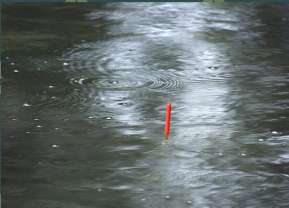I'd toss my topwater to one of those pockets, twitch it a couple of times, and bam! I'd have a fish blow up on the bait. In quick order that morning, I put three keepers in the livewell.
Saw some more pockets of bubbles this past Saturday but didn't attain the same degree of success. As a result, I decided to do some online research and find out what the meaning really is behind those bubbles I've seen so many times.
Come to find out that many of them are not caused by fish at all but, rather, by natural underwater processes. For example, pockets of gas form naturally in the substrate of all waters. These result from bacterial breakdown of organic matter, and any disturbance of the substrate, be that by fish, wild fowl, or water movement, cause it to be expelled...in the form of bubbles on the surface.
Bubbling is certainly more prevalent in areas of organic matter, such as silt, where bacterial activity is at its greatest, but it's common over hard gravel substrates, too. The nature of the gas released varies, depending upon the nature of the substrate, particularly whether the breakdown is aerobic or anaerobic.
In addition to bacterial generation of gases within the substrate, bubbles also are formed by the feeding and regulatory processes of fish themselves. Release of bubbles through the gills is part of the sorting process, whereby fish separate food from nonfood items, and depth-regulation mechanisms often require fish to release gas from their swim bladder as they rise in the water column.
Differentiating between those bubbles created by fish and those arising from natural means is part of the learning process. Watercraft comes with experience, and the more you study the water the better you get, but there are some clues to help you along the way.
Bubbles produced by the physical feeding process and depth regulation tend to be relatively large and short-lived. In other words, they "pop" shortly after breaking the surface. In the case of larger feeding fish, two lines of bubbles sometimes may be observed, one emanating from each gill, although it's not always evident. Smaller, more persistent bubbles, often producing a thin foam, tend to be caused by fish feeding over silt, and often are interspersed by occasional, larger bubbles, resulting from physical expulsion from the gills amidst the release of the gases trapped in the silt.
The key to differentiating feeding fish bubbles is that they "move" as the fish moves across the substrate. Naturally released gas bubbles tend to be static, often emanating from a single source, where an area of silt has become ruptured.
You can, at times, observe huge "sheets" of fish bubbles rising to the surface, often covering a large area. These usually are caused by a fish rolling on the lake or river bed, and it is typical carp or catfish behavior, where the length and bulk of a big fish burrowing through or rolling on silt disturbs large areas of trapped gas.
The size and nature of the fish bubbles can be related to the species of fish causing them to a certain extent. Bream beds in the summertime, for example, display a bunch of tiny bubbles coming to the surface. Carp and catfish bubbles, on the other hand, are noticeably larger and have a tendency to be shorter-lived. Veteran swampers can even locate big snapping turtles by seeing a certain kind of bubbles. And, if you happen to be in an area with alligators, such as Louisiana, keep a close watch for a trail of big bubbles heading off in a straight line.
So, the next time you're on the water, don't pass up the chance to throw at some bubbles. It just might make your day.


No comments:
Post a Comment